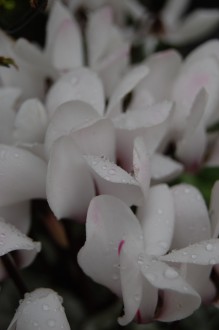Position: Full sun to partial shade
Flowering period: Late autumn to early winter
Soil: Moist, well drained
Eventual Height: 15cm
Eventual Spread: 15cm
Hardiness: 4b, 5a, 5b, 6a, 6b, 7a, 7b, 8a, 8b, 9a, 9b
Family: Myrsinaceae
Cyclamen hederifolium var. hederifolium f. albiflorum is a low growing tuberous perennial. The summer time is the dormant period for this plant and in most instances the leaves will not be in evidence. The leaves of this plant are notoriously variable. However the leaves are generally Ivy like, dark green or grey-green with a well-marked hastate pattern, mat above and beneath and finely toothed. The flowers are pure white, sometimes with pale pink in the throat. After fertilisation, the flower stalk coils down to the ground, these contain a seed pod. The round tubers of this plant will grow in time and may achieve a diameter of up to 20cm.
Cyclamen hederifolium var. hederifolium f. albiflorum, commonly known as the Hardy Cyclamen or Ivy-leaved cyclamen, is native to the northern Mediterranean region. This plant is synonymous with Cyclamen neapolitanum. Cyclamen seeds are naturally dispersed by ants, called myrmecochory. The seeds have a sticky covering called an elaiosome which attracts ants. The ants then carry the seed into their nest, eat the elaiosome and discard the seed.

Cyclamen hederifolium var. hederifolium f. albiflorum leaf (17/12/2011, London)
The etymological root of the binomial name Cyclamen is derived from the Greek kyklos ‘ring or circle’ and amen (from the Hebrew) ‘truly’ in reference to the coiled fruiting stalk or shape of the tuber. Hederifolium is derived from the Latin for Ivy, hedera and folium ‘leaf’. Albiflorum is derived from the Latin albo ‘make white’ and flora ‘the goddess of flowers’
The landscape architect may find Cyclamen hederifolium var. hederifolium f. albiflorum useful as a spreading ground cover plant beneath the dry shade of a tree. It will self seed and propagate itself and once established it is drought tolerant during the summer months.
Ecologically, Cyclamen hederifolium var. hederifolium f. albiflorum provide a source of food for ants in the form of the sticky covering on the seed cases.
The Royal Horticultural Society has given the species Cyclamen hederifolium their prestigious Award of Garden Merit in 1993.
Cyclamen hederifolium var. hederifolium f. albiflorum prefers moist, fertile, well-drained soils. It particularly enjoys soils with a high proportion of leaf mould. The tubers dislike wet soils.
Cyclamen hederifolium var. hederifolium f. albiflorum requires little maintenance. The moving or splitting of a crowded clump should be carried out in the dormant summer period.





